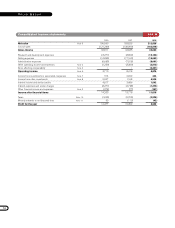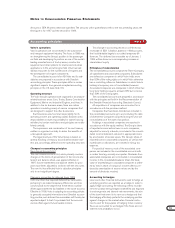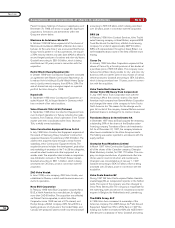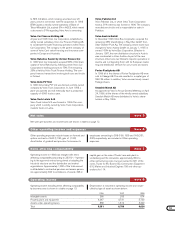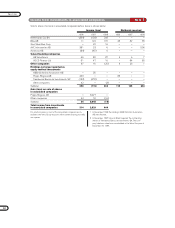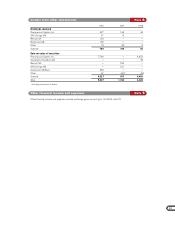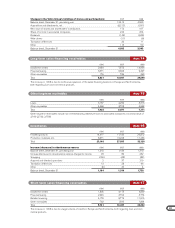Volvo 1998 Annual Report Download - page 58
Download and view the complete annual report
Please find page 58 of the 1998 Volvo annual report below. You can navigate through the pages in the report by either clicking on the pages listed below, or by using the keyword search tool below to find specific information within the annual report.
56
NOTE S
Foreign currencies
In preparing the consolidated financial statements, all
items in the income statements of foreign subsidiaries
(except subsidiaries in highly inflationary economies) are
translated to Swedish kronor at the average exchange
rates during the year (average rate). All balance sheet
items except net income are translated at exchange
rates at the respective year-ends (year-end rate). The
differences in consolidated shareholders’ equity arising
as a result of variations between year-end exchange
rates are charged or credited directly to shareholders’
equity and classified as restricted or unrestricted reserves.
The difference arising in the consolidated balance sheet
as a result of the translation of net income in foreign
subsidiaries to Swedish kronor at average rates is char-
ged or credited to unrestricted reserves. Movements in
exchange rates change the book value of foreign associ-
ated companies. This difference affects restricted reser-
ves directly.
When foreign subsidiaries and associated companies
are divested, the accumulated translation difference is
reported as a realized gain/loss and, accordingly, affects
the capital gain.
Financial statements of subsidiaries operating in highly
inflationary economies are translated to Swedish kronor
using the temporal method. Monetary items in the balance
sheet are translated at year-end rates and nonmonetary
balance sheet items and corresponding income state-
ment items are translated at rates in effect at the time
of acquisition (historical rates). Other income statement
items are translated at average rates. Translation differ-
ences are credited to, or charged against, income in the
year in which they arise.
In the individual Group companies as well as in the
consolidated accounts, receivables and liabilities in
foreign currency are valued at year-end exchange rates.
In appropriate cases, receivables and liabilities are valued
at the underlying forward rate. In the individual Swedish
Group companies, unrealized exchange gains on long-
term receivables and liabilities are allocated to an
exchange reserve, which is included in untaxed reserves.
Gains and losses pertaining to hedges are reported at
the same time as gains and losses of the items hedged.
Received premiums or payments for currency options,
which hedge currency flows in business transactions are
reported as income/expense during the contract period.
Gains/losses on outstanding currency futures at year-
end, which were entered into to hedge future commercial
currency flows, are reported at the same time as the
commercial flow is realized. For other currency futures
outstanding, a valuation is made whereby a provision for
unrealized losses is made to the extent they exceed
unrealized gains.
In valuing loans whose original currency denomination
has been changed as a result of currency swap con-
tracts, the loan amount is accounted for translated to
Swedish kronor taking into account the swap contracts.
Exchange differences on loans and other financial
instruments in foreign currency, which are used to hedge
net assets in foreign subsidiaries and associated com-
panies, are offset against translation differences in the
shareholders’ equity of the respective companies.
Exchange gains and losses on payments during the
year and on the valuation of assets and liabilities in
foreign currencies at year-end are credited to, or
charged against, income before taxes and minority inter-
ests in the year they arise. The more important exchange
rates employed are shown above.
Other financial instruments
Interest and currency rate swaps are used to change the
underlying loans structure and are reported as hedges
against such loans.
Interest-rate instruments used as part of the manage-
ment of the Group’s short-term investments are valued
together with these instruments in accordance with the
portfolio method. Provisions are made for unrealized losses
in excess of the unrealized gains within the portfolio.
Interest-rate instruments that do not fullfil the criteria
of hedge accounting are valued at the closing date at
which time provisions for unrealized losses are made.
Capital expenditures for property, plant and
equipment
Capital expenditures for property, plant and equipment
include investments in buildings, machinery and equip-
ment, as well as in intangible assets. Investments per-
taining to assets under operating leases are not included.
Depreciation and amortization of tangible and
intangible non-current assets
Depreciation is based on the historical cost of the
assets, reduced in appropriate cases by write-downs,
and estimated economic life. Capitalized type-specific
tools are generally depreciated over 2 to 8 years. The
depreciation period for assets under operating leases is
normally 3 to 5 years. Machinery is generally depreciated
over 5 to 20 years, and buildings over 25 to 50 years,
while the greater part of land improvements are depreci-
ated over 20 years. In connection with its participation in
aircraft engine projects with other companies, Volvo Aero
in certain cases compensates these companies for part
Exchange rates Average rate Year-end rate
Country Currency 1996 1997 1998 1996 1997 1998
Belgium BEF 0.217 0.214 0.2196 0.215 0.213 0.2341
Denmark DKK 1.158 1.158 1.1897 1.156 1.155 1.2685
Finland FIM 1.463 1.476 1.4930 1.482 1.453 1.5885
France FRF 1.312 1.310 1.3514 1.312 1.314 1.4400
Italy ITL 0.00436 0.0045 0.0046 0.00451 0.0045 0.0049
Japan JPY 0.0618 0.0631 0.0610 0.0593 0.0606 0.0700
The Netherlands NLG 3.982 3.921 4.0202 3.941 3.903 4.2865
Norway NOK 1.040 1.082 1.0520 1.066 1.072 1.0730
Great Britain GBP 10.486 12.496 13.2215 11.605 13.123 13.5200
Germany DEM 4.462 4.412 4.5317 4.423 4.398 4.8295
United States USD 6.712 7.629 7.9676 6.872 7.870 8.0650








